Red River of the South
The Red River, or sometimes the Red River of the South, is a major river in the Southern United States.[2] It was named for its reddish water color from passing through red-bed country in its watershed.[3] It is known as the Red River of the South to distinguish it from the Red River of the North, which flows between Minnesota and North Dakota into the Canadian province of Manitoba. Although once a tributary of the Mississippi River, the Red River is now a tributary of the Atchafalaya River, a distributary of the Mississippi that flows separately into the Gulf of Mexico. This confluence is connected to the Mississippi River by the Old River Control Structure.
| Red River Rivière Rouge (former French name), Río Colorado (former Spanish name) | |
|---|---|
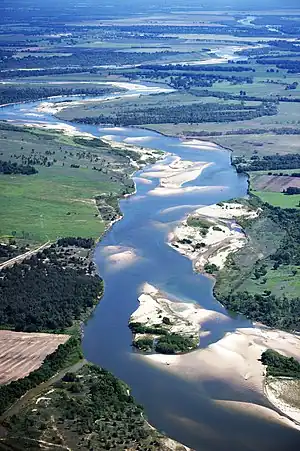 Red River looking east, north of Bonham, Texas:
Texas is to the right, Oklahoma is on the left, and the border between the two states runs along the south (right) bank of the river. | |
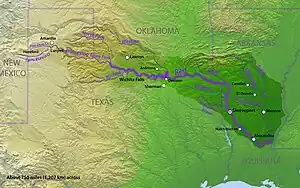 Map of the Red River watershed | |
| Native name | Bah'hatteno (Caddo)[1] |
| Location | |
| Country | United States |
| States | Texas, Oklahoma, Arkansas and Louisiana |
| Physical characteristics | |
| Source | |
| • location | Confluence of the North Fork and Prairie Dog Town Fork, Harmon County, Oklahoma |
| • coordinates | 34°34′35″N 99°57′54″W |
| • elevation | 1,535 ft (468 m) |
| Mouth | |
• location | Atchafalaya River |
• coordinates | 31°01′10″N 91°44′52″W |
• elevation | 30 ft (9.1 m) |
| Length | 1,360 mi (2,190 km) |
| Basin size | 65,595 sq mi (169,890 km2) |
| Discharge | |
| • location | mouth; max and min at Alexandria, LA |
| • average | 57,000 cu ft/s (1,600 m3/s) |
| • minimum | 1,472 cu ft/s (41.7 m3/s) |
| • maximum | 233,000 cu ft/s (6,600 m3/s) |
The south bank of the Red River formed part of the US–Mexico border from the Adams–Onís Treaty (in force 1821) until the Texas Annexation and the Treaty of Guadalupe Hidalgo.
The Red River is the second-largest river basin in the southern Great Plains.[4] It rises in two branches in the Texas Panhandle and flows east, where it serves as the border between the states of Texas and Oklahoma. It forms a short border between Texas and Arkansas before entering Arkansas. It forms much of the eastern border of Miller County, Arkansas, turning south near Fulton and flowing into Louisiana, where it feeds the Atchafalaya River. The total length of the river is 1,360 miles (2,190 km), with a mean flow of over 57,000 cubic feet per second (1,600 m3/s) at the mouth.
Geography
Course
The source of the Red River is the confluence of the North Fork and Prairie Dog Town Fork, in Harmon County, Oklahoma.
Specialists have debated whether the North Fork or the Prairie Dog Town Fork is the true stem.[4] Because of a cartographic error, the land between the north and south forks were claimed by both the state of Texas and the United States federal government. In 1852, Randolph B. Marcy's expedition had followed the Prairie Dog Town Fork.[4] Originally called Greer County, Texas, the US Supreme Court ruled that it belonged to the United States, which at the time oversaw the Oklahoma Territory. That territory was later incorporated into the state of Oklahoma, whose southern border follows the south fork. Today, the southern Prairie Dog Town Fork is considered the main fork, though the North Fork is as long and normally has a greater water flow.[4]
The southern fork is generally considered the main stem of the Red River and about 120 miles (190 km) long. It is formed in Randall County, Texas, near the county seat of Canyon, by the confluence of Tierra Blanca Creek and intermittent Palo Duro Creek (not to be confused with another Palo Duro Creek 75 miles to the north, which drains into the North Canadian River). It turns and flows southeast through Palo Duro Canyon in Palo Duro Canyon State Park at an elevation of 3,440 feet (1,050 m),[4] and past Newlin, Texas, to cross the Oklahoma state line. About 2 miles south of Elmer, Oklahoma, the Salt Fork of the Red River joins from the north. These combined waters receive the North Fork Red River from the north about 10 mi (16 km) west-southwest of Frederick, Oklahoma to form the Red River proper.

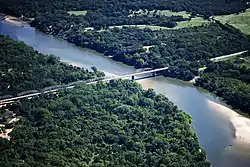
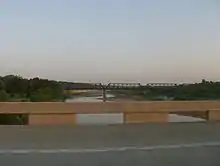

The combined river proceeds to follow a winding course east through one of the most arid parts of the Great Plains, receiving the Wichita River about 25 miles northeast of the city of Wichita Falls. Near Denison, the river exits the eastern end of Lake Texoma, a reservoir formed by the Denison Dam. The lake is also fed by the Washita River from the north. Beyond the dam it runs generally east towards Arkansas and receives Oklahoma's Muddy Boggy Creek on the left bank before turning southward near Texarkana.
Soon after, the waterway crosses south into Louisiana. The sister cities of Shreveport and Bossier City were developed on either bank of the river, as were the downriver cities of Alexandria and Pineville. After being joined from the north by the Black River (downstream name of the Ouachita River, its largest tributary) about 1.5 miles south of Acme, the river broadens into a complex network of marshlands west of the Mississippi River. Its waters eventually become a tributary of the Atchafalaya River[5] and flow generally southward into the Gulf of Mexico.
Tributaries
Tributaries include the Little Red River, Prairie Dog Town Fork Red River, Salt Fork Red River, North Fork Red River, Pease River, Washita River, Kiamichi River, Wichita River, Little Wichita River, Little River, Sulphur River, Loggy Bayou (through Lake Bistineau and Dorcheat Bayou) as well as the Ouachita River (also known as the Black River at that point) not far (at Acme, Louisiana) from the mouth.
Saltwater river
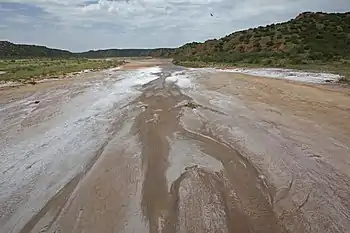
The Red River is salty through tributaries above Lake Texoma. The saltiness is caused by a natural phenomenon that dates back to ancient times. About 250 million years ago, an inland sea blanketed parts of what is now those states. As time passed, that sea evaporated, leaving salt deposits – mostly sodium chloride. Rock and silt eventually buried the deposits, but the salt continues to leach through natural seeps in tributaries above Lake Texoma, sending as much as 3,450 tons of salt per day flowing down the Red River.[6][7]
Watershed
The Red River's watershed covers 65,590 square miles (169,900 km2)[4] and is the southernmost major river system in the Great Plains. Its drainage basin is mostly in the states of Texas and Oklahoma, but also covers parts of New Mexico, Arkansas and Louisiana. Its basin is characterized by flat, fertile agricultural land, with only a few major cities. The drainage basin of the Red River is very arid and receives little precipitation. As a result, much of the river above the Texas–Oklahoma border is intermittent, and until the river is past its great bend south in Arkansas, the flow varies widely. Most of the agriculture in the basin is sustained by groundwater, which is recharged with rainfall and riverflow. The lower course of the river flows through a series of marshes and swamps, where its flow is dramatically moderated.
History
Native Americans
Native American cultures along the river were diverse, developing specialized adaptations to the many different environments.[4] Starting near the headwaters, the Plains division of the Lipan Apache dominated the western Red River area until the 18th century, when they were displaced by invading Comanche from the north.[4] The middle part of the Red River was dominated by the Wichita and Tonkawa. This area was prairie, where Native Americans constructed portable and temporary tepees for housing. They practiced limited farming and followed game in seasonal, nomadic hunting cycles.[4] By the time of European contact, the eastern Piney Woods of the lower river courses were dominated by the numerous historic tribes of the Caddo Confederacy. They found plentiful game and fish, and also had good land for cultivating staple crops.[4]
American exploration and settlement, 1806 onwards

In 1806, President Thomas Jefferson commissioned the Red River Expedition to explore parts of the new lands of the 1803 Louisiana Purchase by traveling up the Red River. Jefferson wrote that the river was "in truth, next to the Missouri, the most interesting water of the Mississippi", in a letter to explorer William Dunbar.[8] Having threaded the maze of bayous at the river's confluence, and the "Great Raft" of lodged driftwood, the expedition was stopped by the Spanish near present-day New Boston, Texas.
In 1806, Lieutenant Zebulon Pike, under orders to ascertain the source of the Red River, ascended the Arkansas River, made his way downstream on what turned out to be the Rio Grande, and was sent home by the Spanish authorities. A more successful exploration of the river's upper reaches to both its sources came with the 1852 expedition under Capt. Randolph Barnes Marcy, assisted by Brevet Capt. George B. McClellan.[9] (A decade later McClellan became an important general in the American Civil War.)
In April 1815, Captain Henry Miller Shreve was the first person to bring a steamboat, the Enterprise, up the Red River. Fulton and Livingston, who claimed the exclusive right to navigate Louisiana waters by steamboat, sued Shreve in the District Court of New Orleans. The judge ruled that the monopoly claimed by the plaintiffs was illegal. That decision, along with a similar outcome in Gibbons v. Ogden, freed navigation on every river, lake or harbor in the United States from interference by monopolies.[10]
When John Quincy Adams became Secretary of State in 1817, one of his highest priorities was to negotiate with Spain about the boundaries of the Louisiana Purchase. He negotiated with Luis de Onís, the Spanish Minister to the United States, and finally concluded the Adams–Onis Treaty, also known as the Treaty of 1819. The treaty defined the south bank of the river as the boundary between the United States and Spain, as of when it was surveyed and demarcated following 1819. That boundary continued to be recognized when Mexico gained its independence from Spain in 1821, and ongoingly when Texas became independent from Mexico in 1835-1836. It remained an official boundary[10] until the United States Congress consented in October 2000 to the Red River Boundary Compact adopted in 1999 by the states of Oklahoma and Texas. This set the jurisdictional boundary between these states at the vegetation line on the south bank, but left title of adjacent property owners at the south bank. (The Red River actively meanders, as shown by a comparison of maps of the political boundaries defined by the river's course decades ago and currently.)
The Red River Campaign (March–May 1864) was fought along the Red River Valley in Louisiana during the American Civil War. It was part of a failed attempt by the Union to occupy eastern Texas. Confederate commander Richard Taylor succeeded in repelling an army under Nathaniel Banks that was three times bigger than his own.
In Louisiana, the area of present-day Natchitoches Parish was settled by French Creole and mixed-race Louisiana Creole people, starting before 1800. The Cane River National Heritage Area is recognized to mark this area of influence, with plantations and churches founded by Louisiana Creoles. Some of the sites are designated as destinations on the Louisiana African American Heritage Trail, established from 2008 onwards. For nearly 100 years after the American Civil War of 1861-1865, some of the plantations were the center of a large African American and Creole community, whose people lived and worked in this area for generations.
The area along the lower Red River of Grant Parish, Louisiana and neighboring parishes had a mixture of hill-country farms and cotton plantations. White planters controlled the large plantations, originally depending on the labor of enslaved African Americans. Subsistence farmers were more common in the hill country and they held few slaves. This was an area of heated social tensions and insurgency during and after the Reconstruction era of 1865-1877. The Reconstruction legislature organized Grant Parish, with the goal of increasing Republican Party representation in the legislature. Most of the blacks joined the Republican Party, which had gained emancipation. But whites resisted black voters and officials. In 1873, Grant Parish became the site of the Colfax massacre, which arose from political tension and violence arising from the disputed 1872 gubernatorial election and from efforts by local whites to maintain white supremacy. White militias, organized from Grant and nearby parishes, killed more than 100 freedmen, some of whom had surrendered as prisoners.
In 1874, such militias organized as the White League in Grant Parish, and other chapters were soon founded across the state. The Coushatta massacre of August 1874 has been attributed by the KnowLA Encyclopedia of Louisiana to the White League, which attacked Republican office-holders to run them out of office.[11] The paramilitary groups intimidated and terrorized freedmen to keep them from the polls and, by the late 1870s, Democrats had retaken political control of the state. They maintained white control of the government and passed laws to establish Jim Crow suppression of blacks.
Great Raft
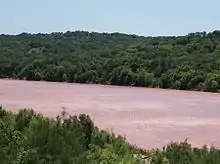
In the early 19th century, settlers found that much of the river's length in Louisiana was unnavigable because of a collection of fallen trees that formed a Great Raft over 160 miles (260 km) long. In 1839, Captain Henry Miller Shreve began clearing the log jam, but it was not completely cleared until the 1870s, when dynamite became available. The river was thereafter navigable, but north of Natchitoches it was restricted to small craft. Removal of the raft further connected the Red and Atchafalaya rivers, accelerating the development of the Atchafalaya River channel.[5]
2015 Red River flood
In June 2015, the Red River flooded parts of northeast Texas, southwest Arkansas, southeast Oklahoma and Louisiana, from Denison Dam, to just south of Alexandria, Louisiana.[12]


Recreation
In 1943, Denison Dam was built on the Red River to form Lake Texoma, a large reservoir of 89,000 acres (360 km2), some 70 miles (110 km) north of Dallas. Other reservoirs on the river's tributaries serve as flood control.
See also
- List of Arkansas rivers
- List of longest main-stem rivers in the United States
- List of Louisiana rivers
- List of Oklahoma rivers
- List of Texas rivers
- Great Raft
- North Fork Red River
- Prairie Dog Town Fork Red River
- Red River Bridge War
- Red River Campaign, 1864, during the American Civil War, 1861–1865
- Adams–Onís Treaty
- Little Red River (Texas)
- Red River Rivalry
References
- Caddo name. Meredith, Howard. "Caddo (Kadohadacho)." Archived 2010-07-19 at the Wayback Machine Oklahoma Historical Society's Encyclopedia of Oklahoma History and Culture. Retrieved 9 Sept 2012)
- Tyson, Carl N. The Red River in Southwestern History. Norman: University of Oklahoma Press, 1981. ISBN 0-8061-1659-5
- "Red River Basin". Texas Water Development Board. Retrieved 5 Dec 2020.
- Benke, Arthur; Colbert Cushing (2005). River of North America. Academic Press. p. 1144. ISBN 9780120882533.
- Piazza, Bryan P (2014). The Atchafalaya River Basin: History and Ecology of an American Wetland. Texas A&M University Press. ISBN 978-1-62349-039-3.
- Malewitz, Jim (21 November 2013). "Communities Along Red River Seek Feds' Help". The Texas Tribune. Retrieved 20 May 2019.
- "U.S. Geological Survey Fact Sheet 170-97". USGS. 1997. Retrieved 20 May 2019.
- Jefferson to Dunbar, 25 May 1805, quoted in T. Lindsay Baker, ed., The Texas Red River country: the official surveys of the headwaters, 1876, 1998: "Foreword", v, and in D.L. Flores, "The Ecology of the Red River in 1806: Peter Custis and Early", The Southwestern Historical Quarterly 88,.1, (July 1984).
- R.B. Marcy, Exploration of the Red River of Louisiana: in the year 1852... with Reports on the Natural History of the Country, Washington, 1853.
- Harbour, Emma Estill. "A Brief History of the Red River County since 1803", Chronicles of Oklahoma. Vol. 16. No. 1. March 1938. Archived 2006-12-08 at the Wayback Machine Retrieved September 7, 2013.
-
Tunnell, Ted (9 December 2013) [6 January 2011]. Johnson, David (ed.). "Coushatta Massacre (1874)". KnowLA Encyclopedia of Louisiana. Louisiana Endowment for the Humanities. Archived from the original on 20 December 2016. Retrieved 8 September 2023.
On the upper Red River, during the last week of August 1894, the White League murdered ten Republicans: four blacks and six whites. [...] The killings all had the same end: the destruction of Republican government in northwestern Louisiana.
- Fuller, Bill (June 11, 2015). "With homes underwater in Louisiana, recovery teams head out". MSN. AP. Retrieved 20 May 2019.
- "Red River of the South". Bridgehunter.com. Retrieved 2017-01-07.
External links
Red River of the South.
- Randolph Marcy, Exploration of the Red River, 1852, hosted by the Portal to Texas History
- Red River from the Handbook of Texas Online
- U.S. Geological Survey Geographic Names Information System: Red River
- Oklahoma Digital Maps: Digital Collections of Oklahoma and Indian Territory
- Red River Compact Commission.
- "U.S. Supreme Court Ruling Leaves Texas High And Dry."
- Geology
- Red River Valley - Engineering Geology Mapping Program PDF files of publications about and maps of the geology of the Red River Valley
- Autin, W. J., and C. E. Pearson, 1993, Quaternary Geology and Geoarchaeology of the Lower Red River Valley: Friends of the Pleistocene South Central Cell 11 th Annual Field Conference Alexandria, Louisiana March 26-28, 1993. Friends of the Pleistocene South Central Cell and Louisiana Geological Survey, Baton Rouge, Louisiana. 183 p.